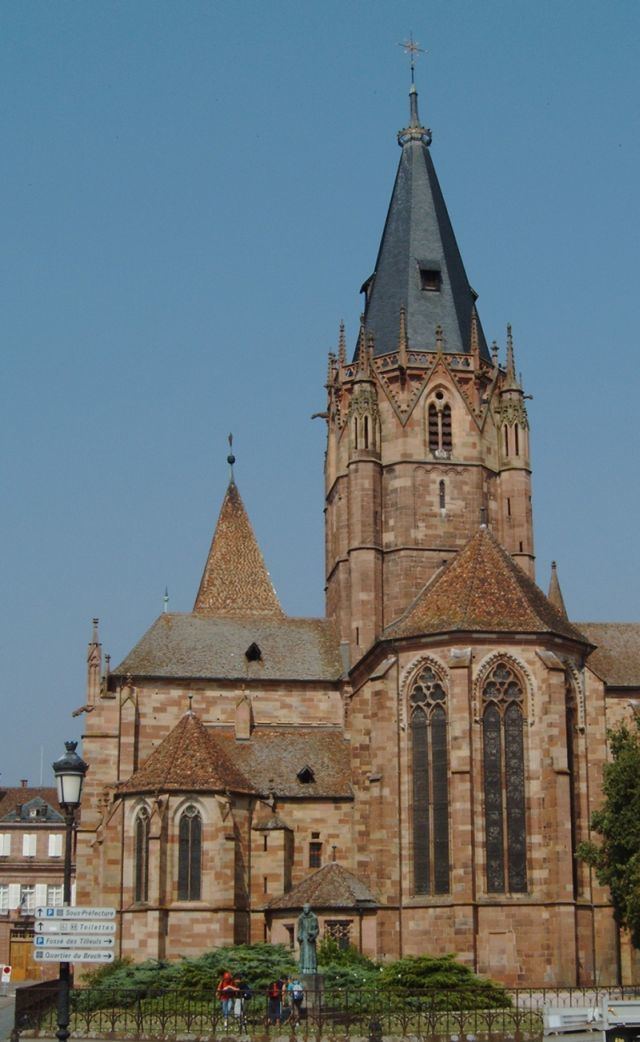 | ||
Weissemburg Abbey (German: Kloster Weißenburg, French: L'abbaye de Wissembourg), also Wissembourg Abbey, is a former Benedictine abbey (1524 –1789: collegiate church) in Wissembourg in Alsace, France.
Contents
History
Weissenburg Abbey was founded around 660 AD by the Bishop of Speyer, Dragobodo.
Thanks to donations from the nobility and local landowners the monastery quickly acquired possessions and estates in the Alsace, Electorate of the Palatinate and in the west-Rhine county of Ufgau. As a result, manorial farms and peasant farmsteads were set up and agriculture system introduced to create fertile arable farmland.
Around 1100, it was important for the monastery, which had now become wealthy, to distance itself from the Bishop of Speyer and his influence. To this end a new tradition was established about the origins of the monastery, backed up by forged documents (it should be noted that such forgery was not anything unusual in the Middle Ages). In the case of Weissenburg, the story now ran that the abbey had been founded in 623 by the Merovingian king, Dagobert I. Detailed historic research in recent decades has demonstrated that this was unlikely to have been the case.
Weissenburg developed quickly into one of the wealthiest and culturally most significant abbeys in Germany. As early as 682 it was able to purchase shares in a saltworks in Vic-sur-Seille for the princely sum of 500 solidi; in 760 it was given the Mundat Forest. The Gospel Book (Evangelienbuch) written around 860 by a monk, Otfrid of Weissenburg, represented a milestone in the development of German language and literature. At that time the abbey was in the charge of Abbot Grimald of Weissenburg, who was also the Abbot of the Abbey of Saint Gall and chancellor to Emperor Louis the German, and thus was one of the most important figures in the whole of the German imperial church.
The abbey lost an important possession, however, when in 985 the Salian Duke Otto appropriated 68 of the parishes belonging to it in the so-called Salian Church Robbery (Salischer Kirchenraub). Above all, though, it was the transition from a situation in which the abbey managed its monastic estates itself to a feudal system in which the estates were granted as fiefs, that resulted in the loss of most of the abbey's possessions. This was because, over time, their vassal viewed their fiefs as allods, i.e. as freehold properties. Thus the once extensive monastic estates increasingly evaporated. In the 16th century only three estates were left out of the thousands the abbey used to possess: these were Steinfeld, Schweighofen and Koppelhof; in addition, the abbey had tithe rights in Weissenburg and Bergzabern which gave it an annual income of 1,500 gulden.
In 1262-1293, during the time of its decline, Abbot Edelin attempted to halt the loss of the monastic estates and to recover its stolen property by compiling a record of the abbey's possessions in a new register. This index, called the Codex Edelini or Liber Possessionum, is currently held in the Speyer State Archives (Landesarchiv Speyer). In 1524, the abbey, now entirely destitute, was turned into a secular collegiate church at the instigation of its last abbot, Rüdiger Fischer, which was then united with the Bishopric of Speyer in 1546.
The princely provost of Weissenberg had an individual vote in the Reichsfürstenrat of the Reichstag of the Holy Roman Empire of the German Nation. In the wake of the French Revolution the foundation was dissolved in 1789.
Part of the monastic library went in the 17th century to the Herzog August Library in Wolfenbüttel, the abbey records largely perished in the confusion of the revolutionary period.
Estates
In 1764 the secular state of the Princely Propstei of Weissenburg comprised the following offices and estates (in today's spelling):
- the Provost's Office with a master of the household (Hofmeister), provost's counsel (Probsteirat), secretaries, architect (Baumeister) and messengers (Boten)
- the court (Staffelgericht) in Weissenburg with nine officials
- the Fauthei of Schlettenbach with four officials and the villages of Bobenthal, Bundenthal, Bärenbach, Finsternheim and Erlenbach
- the Provost's Court (Propsteigericht) in the Zweibrücken district of Kleeburg with three officials
- the districts of Altstadt and St. Remig with eleven officials and the villages of Großsteinfeld, Kleinsteinfeld, Kapsweyer, St. Remig, Schweighofen, Schleithal and Oberseebach
- the stewardship (Schaffnerei) of Hagenau with two officials for St. Walpurga's Abbey
- the Sheriff's Office (Schultheißerei) of Uhlweiler near Hagenau
Towards the end of the 18th century the territories of the Propstei of Weissenburg covered 28 square miles with 50,000 inhabitants.
List of abbots of Weissenburg
In his abbey chronicle which first appeared in 1551, the theologian and historian, Kaspar Brusch, left a record of the abbots of Weissenburg, which appears to be partly fictitious (at least for the abbots who presided before Dragobodo - to wit the rather stylized name of the supposed first abbot, "Principius"). In addition Brusch suggests this himself ("Nihil enim de his Abbatibus primis aliud scriptum reperi, quorum seriem etiam ac successionem aliquid erroris habere non dubito". As the source for the abbots before Adalbertus (No. 23) he discloses that he was given this information by the Bishop of Speyer of that time).
With that ends the series of abbots. The provosts of the collegiate church were identical with the bishops of Speyer.
Source: Caspar Bruschius: Chronologia monasteriorum Gemaniae praecipuorum, Sulzbach, 1681
